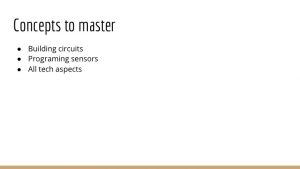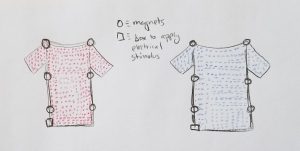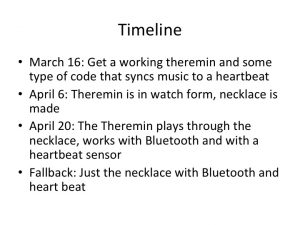







Wearable google home – Shroom
Initial Project Pitch
Project Diagram

Project Description:
My project will use an electromyography (EMG) sensor and Adafruit Circuit Playground Express Development Board I got from the class. Here is how it works: The EMG sensor will receive the electro signal sent from human muscle and transmitted via analog format. The development board which has an ARM Cortex M0 Processor can convert the analog signal into digital format and visualize it via the onboard LED lights gauge and showing it like a bar- like indicator. And if the sensor senses the muscle is putting on maximum strength, the buzzer will sound to alert the person from muscle related injuries.
Inspiration Project
- Muscle Sensor + LED Shield
- The muscle sensor output the analog signal directly into the LED Shield and can display a 10-segment bar graph
Project Sketches

- The final product will look like an armband and has LED indicator with buzzer and/or vibration module
Materials and tools

- MCU: LilyPad Arduino 328 Main Board
- EMG Sensor: MyoWare Muscle Sensor + Biomedical Sensor Pad
- LED: MyoWare LED Shield/LilyPad Pixel Board/SparkFun RGB LED Breakout – WS2812B
- Buzzer: LilyPad Buzzer
- Vibration Motor: LilyPad Vibe Board
- Tools: Soldering Iron, Breadboard
- Miscellaneous:Male & Female header connectors, Jumper wire
MCU: LilyPad Arduino 328 Main Board
The LilyPad Arduino consists of an ATmega328 with the Arduino bootloader and a minimum number of external components to keep it as small (and as simple) as possible. This board will run from 2V to 5V and offers large pin-out holes that make it easy to sew and connect. Each of these pins, with the exception of (+) and (-), can control an attached input or output device (like a light, motor, or switch).
EMG Sensor: MyoWare Muscle Sensor + Biomedical Sensor Pad
This is the MyoWare Muscle Sensor, an Arduino-powered, all-in-one electromyography (EMG) sensor from Advancer Technologies. The MyoWare board acts by measuring the filtered and rectified electrical activity of a muscle; outputting 0-Vs Volts depending the amount of activity in the selected muscle, where Vs signifies the voltage of the power source. It’s that easy: stick on a few electrodes (not included), read the voltage out and flex some muscles!
Skills and concepts
- Soldering
- A/D Converter Basics
- Coding on Arduino Platform
Timeline
- Milestone 1 (March 16): Make the project basic functions work on breadboard
- Milestone 2 (April 6): Test the Valve and Threshold value and test on wearable scenarios
- Milestone 3 (April 20): Fully tested and ensured the project works perfectly during real life situations
Fallback Plan
If it’s not easy to successfully find out the actual workable valve and threshold value for the project to function properly, I can change the project into testing suddenly peaked muscle electro signal to count such as push-ups or sit-ups
Project Member
Sin-Ying Lin
Initial Project Post – Jeff Ma

This wearable technology I wish to create is through interaction with the clothes or with other environments, the status shown on the clothes can be changed to suit the user’s displaying purpose.
It uses an analog switch to change the LED displayed. The LED may also be changed using sensors through interaction with other people and the environment. The platform is prone to change to maybe jacket, beanie, caps etc.
This project is meant to be playful and experimental, it could also be pragmatic depending on what image it displays
Potential consumer:
People who wish to display a status based on the situation on their clothes, gear geeks
Confident:
Programming
Art Experience
Some hardware
Some 3d printing
Not so confident:
Soldering
Sewing
Compactly connecting microcontrollers
Initial Project Pitch
Jeff Brandt
My design is for a shirt that can change colors due to an electrical stimulus. This will be accomplished by magnetized beads on the shirt that will flip their orientation and thus show only one half of the bead that is colored differently than the other half. This is trying to solve a problem for over-packers on work trips or vacations by allowing the user to pack less clothing but still be able to have a different appearance each day.
I am confident in the materials selection process as well as some very basic programming.
I am less confident in the design aspects such as stitching or weaving together fabrics.

Theremin watch/ speaker necklace

… also I took Art Metals so I can make jewelry (kinda)







Michael Leykin: Initial Project Pitch
Name: Michael Leykin
Idea#1: Defense
The 3-factor Bluetooth authentication bracelet!
Sketch:

Purpose: Add additional layers of security to any physical device.
Project is meant to be a pragmatic solution for companies with large number of workstations.
How It Would Work: After application is installed on machine, the Bluetooth bracelet would calibrate to identify you, then from then on, you would have to have the bracelet on when logging into your machine.
Confident Skills: Programming, security knowledge.
Not Confident Skills: Product design, hardware design, electrical engineering and bio metric sensors.
Idea#2: Offense
Penetration of
Endpoints and
Networks
Infiltration
System
Sketch:

Purpose: To perform a vulnerability assessment on a physical location/organization.
This project is not pragmatic at all, the only legitimate use for such a project would be for malicious purposes, so this is mainly experimental and playful.
Again, the only people I could see using this would be a malicious actor or a very dedicated security team.
How it would work: The wearer of this jacket could use a multitude of the pen testing tools present in this jacket to gain a variety of information to send back to your home machine (password hashes, metadata from workstations…etc).
Confident Skills: Programming, Pen testing tool knowledge.
Non-confident Skills: Component integration into a garment, sewing.
Adversarial Temporary Tattoo – John Compas
Adversarial Temporary Tattoo
Fooling AI for the price of a sticker
John Compas
Abstract
Researchers have consistently demonstrated over the past three or four years that image and facial recognition techniques are highly susceptible to attack. Many are not designed to be robust in such a manner, making them vulnerable. I aim to create temporary tattoos or other articles of clothing that can disguise the wearer from facial or object recognition. Potentially, this tattoo could not only obscure the wearer but force the AI to classify them as a different person or object.
Technical Details
Researchers at Carnegie Mellon showed two years ago that it was possible to create psychedelic looking glasses that could massively impact how that person’s face was classified by AI [1]. Since then a number of different studies have had similar success attacking classifiers using a variety of techniques. An open source project dedicated to this idea, CVDazzle, has produced many “anti faces” to conceal the wearer. However, both Carnegie Mellon and CVDazzle’s techniques are relatively human obvious. I aim to create a temporary tattoo while looking “normal” has slight, human undetectable modifications that obfuscate the user’s face or body to image detection algorithms. This has been done by [2] although solely on a pixel-by-pixel basis and not in the real world.
 [3] Turning a banana into a toaster
[3] Turning a banana into a toaster
A team at Google found that a small patch, applied near an object, could disrupt image classifiers. Many of these techniques counted on access to the internal workings of the classification algorithm to work, however. In [4] a team from MIT showed that a “black box” approach to attack Google’s Cloud Vision. With an evolutionary algorithm, they were able to reduce the time taken to obfuscate an image by multiple orders of magnitude. Using a combination of the aforementioned techniques, I would aim to create patterns for temporary tattoos. Ultimately, the goal would be a tattoo that would be innocuous to humans, yet potent to a classification algorithm.


An example: what you see, what Google’s Cloud Vision or FaceID sees
Actually fabricating the tattoos would be trivial. Tattoo paper is cheap and widely available for use with color printers. Likely the most challenging aspect of the project would be to translate simulated pattern success into a real-world demonstration where the lighting and shadows are inconsistent.
Potentially, other objects and fabrics could be demonstrated, but their fabrication is more challenging.
Goals
The purpose of this project is more experimental. Attempts will be made to make these tattoos look normal, but the main purpose will be to successfully attack commercial face recognition technology.
Applications
The implications of this technology, if successful, are widespread. By simply concealing a wearer’s face, security technology at airports and face-ID technology in large cities like London or New York could be massively compromised for little investment.
If fooling a classifier into recognizing you as a different person is also possible, a whole host of new vulnerabilities are exposed. For example, if Apple’s face ID can be exploited, phones and iPads would instantly be vulnerable.
Confident Skills:
Programming (variety of languages)
Hardware Design, PCB Layout
3D Printing
Laser Cutting
Not Confident:
Sewing
Clothing Design
AI
References
[1] https://www.cs.cmu.edu/~sbhagava/papers/face-rec-ccs16.pdf
[2] https://arxiv.org/pdf/1804.04779.pdf
[3] https://arxiv.org/pdf/1712.09665.pdf
[4] https://arxiv.org/pdf/1712.07113.pdf
Project Pitch – Yudong Huang
Synchronization Suit
For the final project, I would like to make a synchronization suit that could assist people with needs of learning poses and moves. In general, it provides wearers with feedback of what part of body to move and where to move. Therefore, it could be helpful especially for performers needing to synchronize their moves.
A good example of how synchronization suit could be useful is learning a dance. As a dancer, I have been leading practices and teaching a dance routine for times, and it really takes me a lot of energy and time. If we could have a wearable tech that provides everyone in a team with feedback of how to move their body in ream time, it could improve whole team’s efficiency and save a lot of time. The idea was first inspired by the yoga learning helper mentioned in class discussion.
Functions
Following are tow main function modes of the suit I could imagine so far.
Real Time Feedback – Each sync suit could be set as a teacher or a learner. When set as learner, it receives signals from a suit set as teacher, and tells the wearer whether his or her moves is synchronized with the teacher. This mode should work when there are more than one suits.
Pre-Record Moves – When working alone, the suit allows the wearer to record a sequence of moves (ex. a dance, a fitness move-pattern) which could be later used to compare with moves of another wearer (either send to another suit or give the suit to another wearer). At the end of comparing, the suit would tell a sync rate to the user as result.

Implementation
Here are some choices I would have to make or difficulties I would face with making the suit.
How to collect data of teacher’s moves? – I think sensors that could collect information of position change would be very helpful in this case. To as clear as much draw the moves of teacher’s whole body, sensors would be placed at each key joint of human body (ex. wrist, elbow, shoulder, chest, crotch, knee).
Feedback should be provided in what ways? – As the wearer could potentially teach / learn numbers of poses and moves, the way of giving feedback should be simple enough and feedback should be easy enough to get no matter in what poses. So far the idea I have come up with is that there would be lighting lines along the side of arms and legs to work as the real time feedback giver. Whether the part of body is in the correct position would be shown in binary colors (ex. green for yes and red for no), and because the lighting lines are along the side of whole body, they already cover the largest space they could cover, which might be easy enough to see.
In what ways to tell wearer the position to move? – This would probably be the hardest part of making the suit. Should the guiding be told visually, or guiding should be transmitted physically through a light force on body? This is an important choice and should be considered and discussed further.
Other Thoughts
As colors are displayed based on whether moves are synchronized, this might be made use of in performing and creating a different visual experience.
Maybe choreographs or move patterns could be designed and edited in software and imported into the suit in the future.
Experimental Materials Development
Michael Sachen
(1) Hypar Pleating
What would one need to accomplish this?
I have- Sewing and Pleating experience
We need- Chemistry skills, i.e. how can we isolate the active ingredient in hair perm product or similar chemicals to permanently set pleats?
What if it doesn’t work? Polyester!
(2) Experimental Dyes
(a) Metal Deposition

By making a soluble metal solution, make it possible to embed metal into fabrics… Who knows the uses?
Fabric that rusts?
Metal color dyes?
What I have- Dye knowledge
What I don’t have- Deep knowledge on metals
Bacteria Dye

Chromatophores, Carotenoids, and Chlorophyll Variants, and PH variation..
Work has been done in this area, but aim to create a semi exhausted attempt to catalog the process of Bacteria dye. What variants change the color and properties of the bacterial dye



